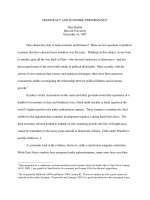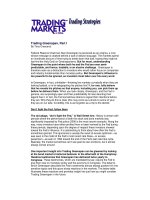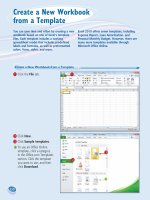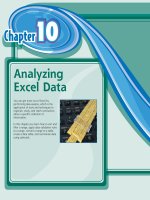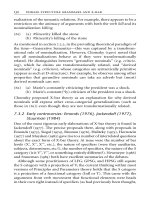Tài liệu Trading Greenspan, Part Ii(pdf) pptx
Bạn đang xem bản rút gọn của tài liệu. Xem và tải ngay bản đầy đủ của tài liệu tại đây (22.35 KB, 2 trang )
Trading Greenspan, Part II
By Tony Crescenzi
In my first lesson, “Trading Greenspan, Part I," I described the best way to trade
Greenspan during the two months when he delivers his Humphrey-Hawkins
testimony. But what about the other ten months? The first step is to recognize
that when Greenspan delivers a policy speech, the impact can span several
months. As I said before, this is because Fed policy doesn’t change on a dime.
Thus, once the Fed’s policies become clear, the markets behave as though they
assume that these policies will be in place for a while.
Your trading strategies,
therefore, should evolve around the notion that Fed pronouncements have
lasting impact.
But how can we decipher where Fed policy stands on a regular basis? I
suggest you become a regular Fed watcher.
Get in their shadows, in other
words. Being a Fed watcher is actually quite simple.
What it boils down to is
merely tracking the verbiage spewed by the FOMC—that cast of 13,
including Greenspan, who vote on whether to raise or lower interest rates
at FOMC meetings
(held eight times per year). There are five additional Federal
Reserve officials who attend the Fed’s meetings, but they vote only every other
year (they are in essence the proverbial flies-on-the-wall at the FOMC meetings).
While their views matter, too, keep your focus on the voting members.
To get you comfortable with Fed watching, think about it this way
: let’s say
that you’ve been asked to solve a mystery where all the principal players are
known; they talk all the time; you get a plethora of clues about what they’re
thinking; they give you verbatim transcripts of what they say; and they give you
the minutes from all of their policy meetings. I’ll bet you can crack that mystery in
a jiffy. Seen in this light, Fed watching looks pretty well-defined and far less
intimidating than most perceive it.
One of the things that I often tell people to do, and that I find many top
investors already do, is to read the text of the Fed’s speeches.
It is not all
that laborious since most speeches are just a few pages long. Reading their
speeches gives you far greater insight than if you simply read headlines from
newswires that largely reflect a reporter’s subjective view about the speeches.
I
strongly believe that no investor should leave it up to reporters to tell them
what they should be thinking about what the Fed said
; it is up to you.
It is
perilous to leave it in the hands of reporters, who often have very little
background on the financial markets and, quite frankly, can be novices
. Do
the work yourself and you will find a dramatic improvement in your mastery over
the state of Fed policy.
What should you look for when you are reading the text? I look for key
phrases that are repeated in lockstep by several Fed members
. When I see
a particular phrase used either verbatim or nearly so by a few members, I always
sense that the phrase is a representation of current Fed policy. When this
happens, I envision Fed members meeting with each other, either in person or by
telephone conference, drawing conclusions about where they stand on policy.
This then finds its way into their public comments. Of course, all Fed members
have their own personal views that they freely express, but this helps us in the
battle to interpret the Fed’s public comments. How? Basically,
if there’s
consistency in the use of phraseology by members known to have bipolar
views on monetary policy (just as a democrat and republican would on the
issue of tax cuts), then their joint use of a particular phrase is generally a
strong indication of agreement over where the Fed stands on a particular
issue.
Last year, for example, just before the Fed began its most recent rate hike cycle,
several Fed members repeatedly used the phrase, “the balance of risks have
shifted (toward higher inflation).” Their common use of this phrase told me that
the Fed was in the midst of formulating a new policy designed to counter those
risks. This, of course, meant that rate hikes were on the way and they did indeed
follow.
It is always striking to me to think that if I simply follow the words of a
handful of people (the Fed), I can gain insights that I believe give me an
edge on millions of investors. That is why I always include the Fed in my
required readings
.
Greenspan the Chameleon
Now that I have given you insights into Trading Greenspan, there is one
last thing to keep in mind: Greenspan is a chameleon. He changes his
stripes all the time. He has savoir-faire—he knows the right thing to do at
the right time.
Dogma toward policies that can get quickly outdated or outmoded
doesn’t bog him down. One minute he is the champion of a particular economic
model, the next he scraps it. Greenspan has an indelible record in this regard
and it has served both he and the American economy well.
You need simply
avoid getting mired in the belief that you have Greenspan all figured out.
Greenspan’s views, you see, evolve with the times.
The best example of this, of course, was his recent near-total abandonment
of the traditional view that strong economic growth leads to inflation.
This
critical shift gave him the presence of mind to “permit” the economy to grow at an
average rate of more than 4% over the past four years, a rate long considered to
be well above the 2.5% speed limit that the Fed has historically used as their
guide in the formulation of monetary policy.
Greenspan deftly saw that things were indeed different this time. He sensed that
the implementation of new technology and innovations had changed the rules of
the game. Greenspan, therefore, became more tolerant of strong growth than his
past record would have led you to believe.
Incredibly, Greenspan saw that the
current period might be, as he called it, a “once-in-a-century period of
innovation.” Once-in-a-century indeed. That’s an appellation that belongs
to Greenspan
.
Copyright © 2001 by TradingMarkets.com, Inc.



